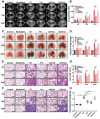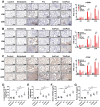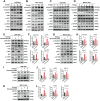Nintedanib Mitigates Radiation-Induced Pulmonary Fibrosis by Suppressing Epithelial Cell Inflammatory Response and Inhibiting Fibroblast-to-Myofibroblast Transition
- PMID: 38993568
- PMCID: PMC11234214
- DOI: 10.7150/ijbs.92620
Nintedanib Mitigates Radiation-Induced Pulmonary Fibrosis by Suppressing Epithelial Cell Inflammatory Response and Inhibiting Fibroblast-to-Myofibroblast Transition
Abstract
Radiation-induced pulmonary fibrosis (RIPF) represents a serious complication observed in individuals undergoing thoracic radiation therapy. Currently, effective interventions for RIPF are unavailable. Prior research has demonstrated that nintedanib, a Food and Drug Administration (FDA)-approved anti-fibrotic agent for idiopathic pulmonary fibrosis, exerts therapeutic effects on chronic fibrosing interstitial lung disease. This research aimed to investigate the anti-fibrotic influences of nintedanib on RIPF and reveal the fundamental mechanisms. To assess its therapeutic impact, a mouse model of RIPF was established. The process involved nintedanib administration at various time points, both prior to and following thoracic radiation. In the RIPF mouse model, an assessment was conducted on survival rates, body weight, computed tomography features, histological parameters, and changes in gene expression. In vitro experiments were performed to discover the mechanism underlying the therapeutic impact of nintedanib on RIPF. Treatment with nintedanib, administered either two days prior or four weeks after thoracic radiation, significantly alleviated lung pathological changes, suppressed collagen deposition, and improved the overall health status of the mice. Additionally, nintedanib demonstrated significant mitigation of radiation-induced inflammatory responses in epithelial cells by inhibiting the PI3K/AKT and MAPK signaling pathways. Furthermore, nintedanib substantially inhibited fibroblast-to-myofibroblast transition by suppressing the TGF-β/Smad and PI3K/AKT/mTOR signaling pathways. These findings suggest that nintedanib exerts preventive and therapeutic effects on RIPF by modulating multiple targets instead of a single anti-fibrotic pathway and encourage the further clinical trials to determine the efficacy of nintedanib in patients with RIPF.
Keywords: Epithelial cells; Fibroblast-to-myofibroblast transition.; Inflammatory response; Nintedanib; Radiation-induced pulmonary fibrosis.
© The author(s).
Conflict of interest statement
Competing Interests: The authors have declared that no competing interest exists.
Figures









Similar articles
-
Biochanin-A ameliorates pulmonary fibrosis by suppressing the TGF-β mediated EMT, myofibroblasts differentiation and collagen deposition in in vitro and in vivo systems.Phytomedicine. 2020 Nov;78:153298. doi: 10.1016/j.phymed.2020.153298. Epub 2020 Aug 1. Phytomedicine. 2020. PMID: 32781391 Free PMC article.
-
Glycyrrhetinic Acid Mitigates Radiation-Induced Pulmonary Fibrosis via Inhibiting the Secretion of TGF-β1 by Treg Cells.Int J Radiat Oncol Biol Phys. 2024 Jan 1;118(1):218-230. doi: 10.1016/j.ijrobp.2023.08.005. Epub 2023 Aug 14. Int J Radiat Oncol Biol Phys. 2024. PMID: 37586613
-
Antifibrotic and anti-inflammatory activity of the tyrosine kinase inhibitor nintedanib in experimental models of lung fibrosis.J Pharmacol Exp Ther. 2014 May;349(2):209-20. doi: 10.1124/jpet.113.208223. Epub 2014 Feb 20. J Pharmacol Exp Ther. 2014. PMID: 24556663
-
Potential of nintedanib in treatment of progressive fibrosing interstitial lung diseases.Eur Respir J. 2019 Sep 19;54(3):1900161. doi: 10.1183/13993003.00161-2019. Print 2019 Sep. Eur Respir J. 2019. PMID: 31285305 Free PMC article. Review.
-
Regulation of myofibroblast dedifferentiation in pulmonary fibrosis.Respir Res. 2024 Jul 18;25(1):284. doi: 10.1186/s12931-024-02898-9. Respir Res. 2024. PMID: 39026235 Free PMC article. Review.
Cited by
-
Identification and validation of CDC20 and ITCH as ubiquitination related biomarker in idiopathic pulmonary fibrosis.Hereditas. 2025 Apr 1;162(1):50. doi: 10.1186/s41065-025-00401-y. Hereditas. 2025. PMID: 40170095 Free PMC article.
-
Epithelial Cell Dysfunction in Pulmonary Fibrosis: Mechanisms, Interactions, and Emerging Therapeutic Targets.Pharmaceuticals (Basel). 2025 May 28;18(6):812. doi: 10.3390/ph18060812. Pharmaceuticals (Basel). 2025. PMID: 40573209 Free PMC article. Review.
-
Pediatric differentiated thyroid carcinoma leading to fatal lung fibrosis.Eur Thyroid J. 2025 Feb 24;14(1):e240341. doi: 10.1530/ETJ-24-0341. Print 2025 Feb 1. Eur Thyroid J. 2025. PMID: 40023147 Free PMC article.
-
Advances in understanding the role of interleukins in pulmonary fibrosis (Review).Exp Ther Med. 2024 Nov 28;29(2):25. doi: 10.3892/etm.2024.12775. eCollection 2025 Feb. Exp Ther Med. 2024. PMID: 39650776 Free PMC article. Review.
-
Radiation-Induced Fibrosis in Head and Neck Cancer: Challenges and Future Therapeutic Strategies for Vocal Fold Treatments.Cancers (Basel). 2025 Mar 26;17(7):1108. doi: 10.3390/cancers17071108. Cancers (Basel). 2025. PMID: 40227628 Free PMC article. Review.
References
-
- Aguado-Barrera ME, Sosa-Fajardo P, Gomez-Caamano A, Taboada-Valladares B, Counago F, Lopez-Guerra JL. et al. Radiogenomics in lung cancer: Where are we? Lung Cancer. 2023;176:56–74. - PubMed
-
- Xia C, Shi W, Zhang Y, Ding L, Gao L, Wang Q. et al. Prevention and treatment of radiation-induced lung injury. Future Med Chem. 2020;12:2161–73. - PubMed
-
- Marks LB, Yu X, Vujaskovic Z, Small W Jr, Folz R, Anscher MS. Radiation-induced lung injury. Semin Radiat Oncol. 2003;13:333–45. - PubMed
MeSH terms
Substances
LinkOut - more resources
Full Text Sources
Medical
Miscellaneous

